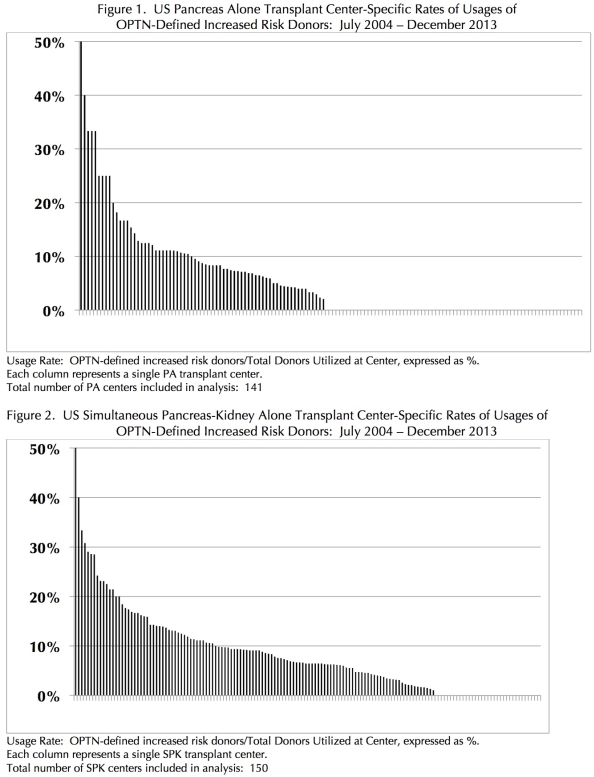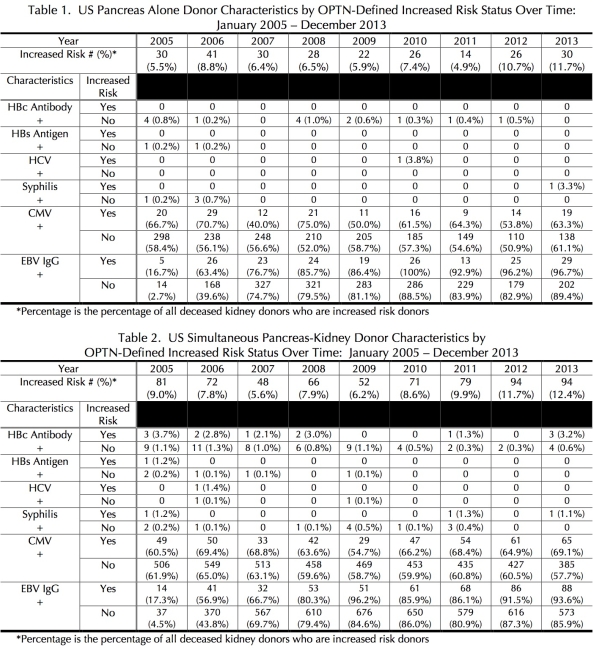Utilization and Characteristics of Pancreas and Simultaneous Kidney-Pancreas Donors in the US by OPTN-Defined Increased Risk Donor Status
1Infectious Diseases, Northwestern University, Chicago
2Organ Transplantation, Northwestern University, Chicago.
Meeting: 2015 American Transplant Congress
Abstract number: A235
Session Information
Session Name: Poster Session A: Non Organ Specific, Economics, Public Policy, Allocation, Ethics
Session Type: Poster Session
Date: Saturday, May 2, 2015
Session Time: 5:30pm-7:30pm
 Presentation Time: 5:30pm-7:30pm
Presentation Time: 5:30pm-7:30pm
Location: Exhibit Hall E
Background: The number of candidates in need of pancreas transplantation is far larger than the number of organ donors. To expand the organ pool, there has been increased used of OPTN-defined increased risk (IR) donors (D). The utilization and epidemiology of infectious disease marker positivity of these IR pancreas alone (PA) and simultaneous kidney-pancreas (SPK) donors has not been previously described.
Methods: We obtained data from the US OPTN to perform a blinded assessment of transplant center-specific utilization of OPTN-defined increased risk donors and the epidemiology of infectious disease marker positivity of PA and SPK IRDs and non-IRDs from July 2004 – December 2014. Student's T-test was used to compare groups.
Results: IRDs accounted for 5.5 – 11.7% of PA donors during the study period (see Table 1) and over time there was a trend towards increased utilization of IRDs. Of the 141 US PA transplant centers 33 (23.4%) had ≥ 10% utilization of IRDs while 72 (50.1%) did not utilize any OPTN-defined IRDs during the 8.5 years studied (See Figure 1).
IRDs accounted for 5.6 – 12.4% of SPK donors during the study period (see Table 2) and over time there was a trend towards increased utilization of IRDs. Of the 150 US SPK transplant centers, 50 (33.3%) had ≥ 10% utilization of IRDs while 34 (22.7%) did not utilize any OPTN-defined IRDs during the 8.5 years studied (See Figure 2).
There was only rare utilization of HBsAg, HBcAb and HCV seropositive organs in PA and SPK transplants.
Conclusions: There is significant variability in the use of OPTN-defined IRDs by US PA and SKP transplant centers and seropositive organs were rarely used. Further analysis is ongoing to assess the outcomes of both groups.


To cite this abstract in AMA style:
Ison M, Ho B, Leventhal J, Ladner D. Utilization and Characteristics of Pancreas and Simultaneous Kidney-Pancreas Donors in the US by OPTN-Defined Increased Risk Donor Status [abstract]. Am J Transplant. 2015; 15 (suppl 3). https://atcmeetingabstracts.com/abstract/utilization-and-characteristics-of-pancreas-and-simultaneous-kidney-pancreas-donors-in-the-us-by-optn-defined-increased-risk-donor-status/. Accessed December 28, 2025.« Back to 2015 American Transplant Congress
